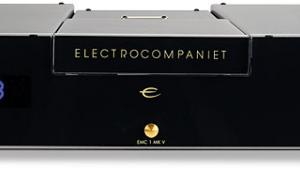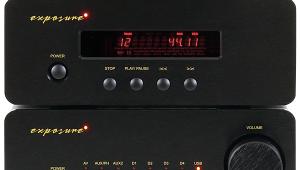Naim Cdx2/dac (£3390/£1995)
It's been a long time coming, but Naim has finally unveiled its first standalone DAC, able to improve the performance of its CDX2 and promising zero jitter, to boot
VERDICT
Naim Audio held out against the outboard D-to-A converter longer than most but there’s no evidence of the new Naim DAC being in any way behind the game as a result. It may have arrived late – but what an entrance. Constructed with Naim’s traditional no-nonsense, robust simplicity, it delvers spacious, dynamic yet insightful sound on its own, and really blossoms when used with the XPS external supply.
From almost anybody else, the launch of a new outboard DAC would rate as one of the audio industry’s more mundane events. But a DAC from Naim Audio – called, yes, the Naim DAC – is a development of more moment. Not so much for what it is but because it unravels what was, until now, one of the marque’s design dogmas. Naim was late to the digital audio party, launching its first CD player in 1991, almost a decade after Compact Disc’s arrival. Even then, it idiosyncratically refused to equip its silver disc spinners with digital outputs, on the basis that a one-box solution – disc mechanism and digital-to-analogue converter circuitry combined – will always give better sound than a two-box one, where the disc reading and conversion functions are physically separated. Naim had a point in that difficulties do indeed arise with recovering the master clock from ‘embedded clock’ interfaces like S/PDIF and AES/EBU. But while Naim declared the problem insuperable, others in the audio industry knuckled down and, by various means, overcame it.
THE SALISBURY SOLUTION
Only now has Naim felt it appropriate to follow suit but that’s not to say that the Naim DAC is by any means a me-too product – it manifestly is not. Naim has developed its own solution to the S/PDIF jitter issue, comprising a buffer memory and switchable fixed-frequency master oscillators which are alternated in order to match, on average, the input data rate. It has also deployed optical data couplers within to provide ground isolation, opted for 40-bit floating point processing rather than the more usual 32-bit to ensure sufficient accuracy with 24-bit source material, and chosen to use an IIR rather than FIR digital filter because the reduced computational load was found to benefit the sound, even when the filters’ amplitude and phase responses were identical.
Of course, Naim’s digital source components have had to be upgraded to incorporate S/PDIF output. Here too an unusual approach is taken in that the S/PDIF circuitry is disabled when the player’s own analogue output stages are enabled. This doesn’t just mean that the digital outputs are switched off: power is removed from the S/PDIF modulator to prevent it radiating radio frequency interference. AES/EBU balanced digital interconnection is not supported, by the way, on the basis that its higher voltage only exacerbates RF interference issues.
Although the DAC has USB inputs front and rear, these are for the connection of a memory stick or iPod/iPhone, not for the streaming of audio from a computer. A FireWire interface is eschewed too, so if you want to couple the Naim DAC to a computer for hard disk replay it will need to have S/PDIF output.
This restricted range of digital interfaces apart, the Naim DAC appears much like any other outboard DAC. Four S/PDIF inputs are provided, via Toslink optical or coaxial inputs, and are selectable via front panel buttons. Remote control input and output sockets are also provided. Two of the coax digital inputs are on 75ohm BNC sockets, the other two on phonos. A front panel LED indicates digital lock, while a second labelled ‘hd’ indicates that the input sampling rate is higher than 48kHz.
TIME TO SWITCH
There are, though, two slide switches on the rear panel that are out of the ordinary. The first selects whether the analogue signal appears on the DIN or phono output sockets; the second, labelled chassis/floating, determines whether the audio circuitry is connected to earth internally or via the components to which it is connected. The choice can have a significant effect on sound quality, so it’s worth taking time to determine which gives the best result. In my system, with the DAC connected to a passive preamp incorporating a DACT stepped attenuator and thence to a pair of Exposure XVIII Mono power amplifiers, I preferred the floating setting, just as I did when reviewing Naim’s HDX hard disk player in HFN December 2009.
The only other unusual feature – although familiar from other Naim equipment – is the multi-pin connector on the back panel via which the optional XPS external power supply (£2995) is connected (the costlier 555 PS is not compatible with the DAC). An XPS was provided for this review to assess its effect, as was Naim’s mid-range CDX2 CD player (£3390) to determine the benefit of hooking the DAC up to it. To assess the Naim DAC with high sampling rate material, I used the S/PDIF outputs of a Prism Sound Orpheus FireWire audio interface, fed by a Mac Mini running Windows XP and the Foobar audio player.
LOST IN MUSIC
I don’t know about you but every now and then I trawl my music collection for items that have slipped the memory. Occasionally I even turn up a CD that, somehow, I’ve simply never played. Which is precisely how I came to use Arcadi Volodos’ performance of Schubert solo piano works [Sony SICC 70, Japanese import] as the first piece for formal comparison of the CDX2 and CDX2/DAC. What a fool I’ve been to let this disc languish so long: within the first few bars of playing it, initially via the CDX2/DAC combination, I knew it to be the best piano recording I have, and very probably the best I’ve ever heard. The sound is weightily dynamic but also delicate as required, spacious but with no sense of subtle timbral details being clouded in reverberant fog. I’m not the greatest fan of solo piano music, let alone Schubert, but I was riveted from the start. That, in a sentence, is what great hi-fi is all about.
Before comparing the sound via the CDX2 alone, I was careful to heed advice to power up its analogue output stage and ‘work’ it for some time prior to listening, which I did by connecting the analogue outputs to the passive preamp, turning the volume right down and playing a disc on repeat for the better part of two days.
Even after taking this trouble, though, the sound of the CDX2 alone was thoroughly eclipsed by the addition of the DAC. The CDX2 is a fine CD player, no question, but that’s how it sounded: like a CD player. A little mechanical in its music making, a little hard on fortés, a little lacking in overall ease. With the DAC in circuit, by comparison, I could have been persuaded that I was listening to a hi-res recording. The music had a difficult to describe but easy to identify flow to it that was missing previously, the dynamic contrasts were greater, and there was no sense of the instrumental sound hardening and congesting on climaxes. All told the sound was significantly closer to that of a real piano, and the quality of both playing and recording shone through. Magical.
FREE AT LAST
From the sublime to the ridiculous? No, but the next track I tried – Free’s ‘I’ll Be Creepin’’ from the Molten Gold anthology [Island CRNCD 2 518 456-2] – was certainly a contrast, and not just musically. Nobody would call this an audiophile recording for a start, although even given its notably left-right mix it’s better than many a rock recording of the era. I hadn’t expected the contrast between CDX2 and CDX2/DAC to be quite so apparent with this second rediscovery from my disc trawl but I was dead wrong – if anything, the contrasts were greater.
Immediately noticeable was the flatter imaging of the CDX2, which gave relatively little sense either of overall depth or of space around individual elements in the mix. With the DAC in circuit the sound was much more expansive, and not just spatially but dynamically and rhythmically too. You could really believe that this was close to the sound of the master tape. No, this is no demonstration piece but how I wish that the still wet behind the ears younger me could have heard Free recordings reproduced like this while Paul Kossoff was still alive. I might have bought a long wig and bunked off to a gig.
Of course, I tried other comparisons of the CDX2 with and without the DAC, always with much the same outcome. No question, the DAC lifts the CDX2 on to a new plane. So what happens when the DAC is powered by an XPS? More of the same? Not quite.
The XPS’s most profound effect is on dynamics. Returning to the Volodos, the piano sound was more sharply etched, even more solid, and louder. Now there was a time when audio pundits would insist that anything that sounded louder must be worse because it was generating more distortion. Well, they obviously never heard this kind of louder which has everything to do with dynamic alacrity and weight, and nothing whatever to do with THD.
It may seem crazy that the XPS should cost half as much again as the DAC itself, but as an upgrade it is unquestionably effective. Once you’ve heard the DAC with XPS connected, you wouldn’t want to be without it. Simple as that.
MORE VITAL
The combination delivers on hi-res programme too. With the DAC/XPS hooked up to the Prism Sound Orpheus I was able to compare it directly with the Orpheus’s own converters, initially on the 24/96 version of Diana Krall’s ‘Narrow Daylight’, ripped from the DVD-A side of The Girl In The Other Room DualDisc [Verve B0003758-82].
Without doubt the Naim combination was better, removing a slight veiling apparent via the Orpheus’s analogue outputs to reveal a more vital, vivid performance in which all the elements were better resolved and more tightly controlled. Bearing in mind that the Orpheus offers eight channels of D-to-A conversion, and much else besides, for only a little more than the cost of the XPS alone, this is as it should be, of course – but the Orpheus is no pushover.
It was the same with the Blue Man Group’s ‘Sing Along’ from ‘The Complex’ DVD-A [DTS Entertainment 69286-01120-9-4], also a 24/96 recording. The Naim combination was tighter, and delivered the punchy synthesised bass line with great power and precision.
My experience of the Naim Audio product range – while much greater than it was a few months ago – is not wide enough to be dogmatic about this but I suspect the DAC is one of the best value products Naim now makes. It is certainly a very fine outboard DAC, and with the optional XPS becomes more exceptional still. It was a long time coming – but well worth the wait.
VERDICT
Naim Audio held out against the outboard D-to-A converter longer than most but there’s no evidence of the new Naim DAC being in any way behind the game as a result. It may have arrived late – but what an entrance. Constructed with Naim’s traditional no-nonsense, robust simplicity, it delvers spacious, dynamic yet insightful sound on its own, and really blossoms when used with the XPS external supply.
Sound Quality: 83%
Originally published in the June 2010 issue

























































